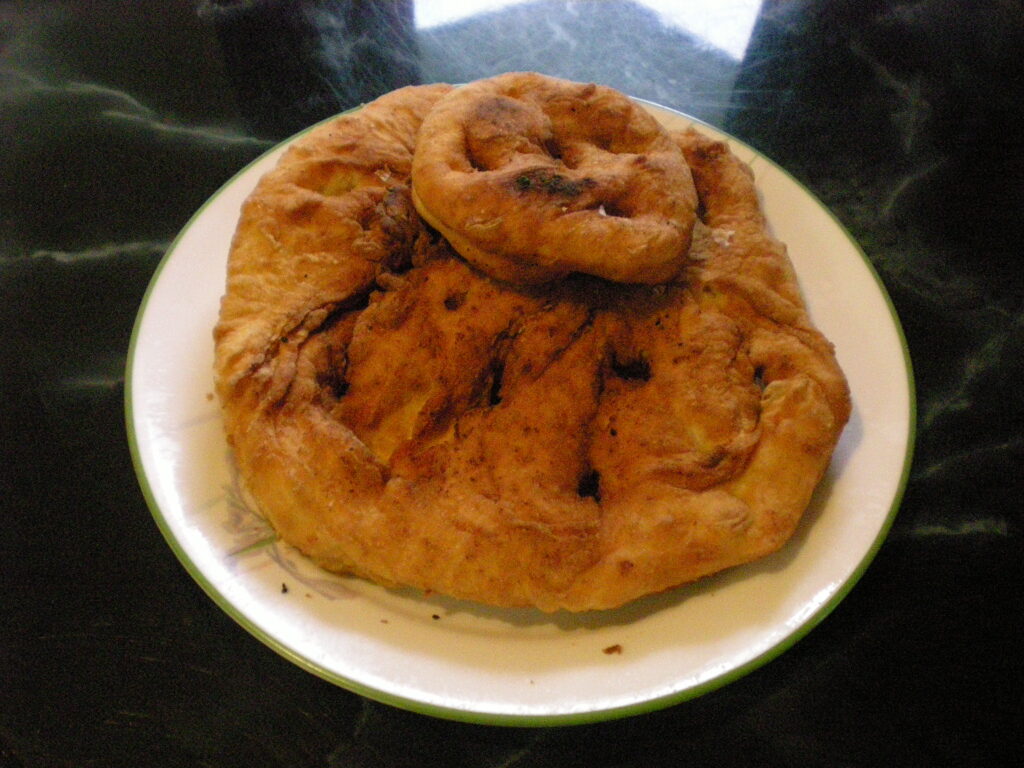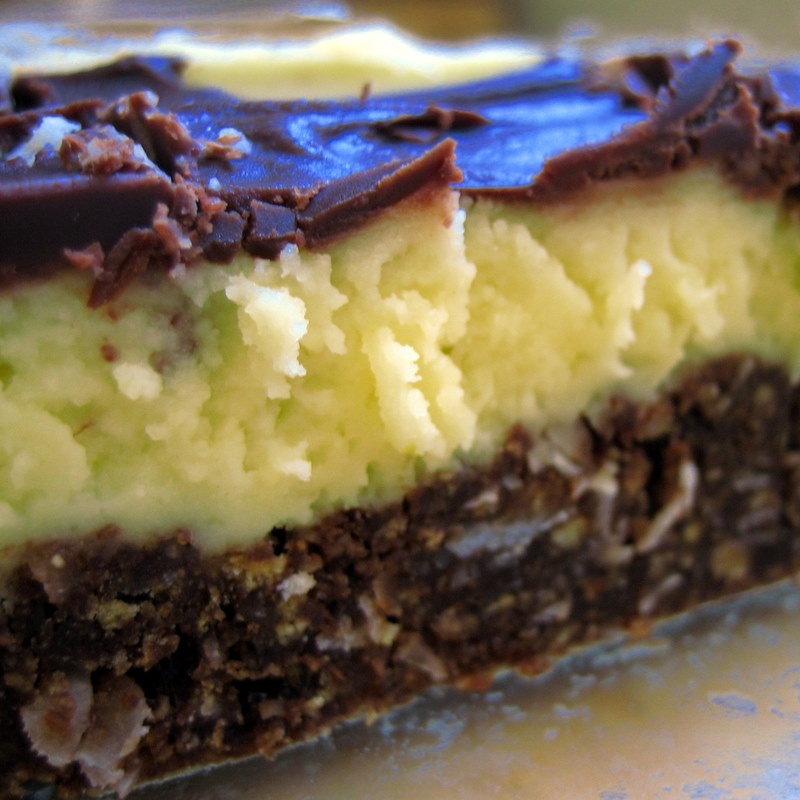Why the east coast of Canada and the USA are at their best in September
Canadian Food: Top 25 Traditional Dishes You Need To Try
The Canadian food scene is as diverse and rich as its landscapes, offering an array of flavors that reflect the nation’s multicultural heritage. From coast to coast, unique regional dishes showcase the local ingredients and traditions that have been passed down through generations. From the hearty comfort of poutine to the sweet indulgence of butter tarts, each of these Canadian dishes tells a story about its history and the people who have shaped its gastronomic identity. So, prepare your taste buds and enjoy a read though some of Canada’s culinary creations.
What is Canada’s national dish?
Deliciously heartwarming, with its combination of French fries, cheese curds and brown gravy, Poutine is known as Canada’s national dish. According to The Canadian Encyclopedia, poutine made its debut in rural Quebec snack bars during the late 1950s. The pronunciation of the word varies across Canada, with those in Quebec saying “poo-tin” while others outside the province often pronounce it as “poo-teen.” The origins of poutine are just as uncertain, with multiple individuals claiming that they were the ones who created this iconic dish. Whatever its origins, despite not being haute cuisine, when asked what is the most popular food in Canada? The answer is always Poutine, a seriously tasty Canadian food that makes an appearance on many a restaurant menu.
Is Canadian food like American food?
Though neighbors with many culinary similarities, it is Canadia’s colonial history which gives its food a unique identity from that of the US. You’ll see considerable overlaps between Canadian culinary practices and those of the British Isles, France as well as the rest of North America.
Many provinces in Canada have touches of French influence in their food but Quebec especially is a hot spot for both French culture and food. Dishes like poutine and pea soup are French-Canadian delicacies hailing from the Quebec area. English pubs are a novelty in the US but are commonplace throughout Canada making fish and chips and other British staples commonplace. Traditionally used ingredients native to the region include moose, caribou, elk, seal, whale, buffalo and all kinds of fish.
1. Nova Scotia Lobster Roll
The classic Nova Scotia Lobster Roll has no equal in the food world. Served on a hot dog bun, lobster meat is mixed with mayonnaise, chives, dill, garlic and zest of lemon. This quintessential Canadian food is also a culinary highlight of neighboring Prince Edward Island.
First appearing in restaurants in Connecticut during the late 1920s, the lobster roll made its way to East Coast Canada by the 1990s. The perfect food for Nova Scotia, whose lobster has earned a global reputation for its exceptional quality and flavor, and is a highly sought-after delicacy in upscale dining establishments around the world.
For the Mi’kmaq, Nova Scotia’s original inhabitants, lobster and other seafood provided essential nourishment and held significant cultural importance. When European settlers arrived in the 17th and 18th centuries, they did not initially regard lobster as the gourmet item it is today. Instead, it was commonly used as bait for fishing or even as fertilizer for crops.

2. Peameal bacon
Peameal bacon is a wet-cured, unsmoked back bacon made from trimmed lean boneless pork loin rolled in cornmeal. Its name comes from its original coating of crushed yellow peas. The brining technique used in its preparation ensures it remains tender and juicy, making it leaner than traditional bacon.
It’s hard to find peameal bacon outside of Canada, making it a revered treat for visitors. But it’s not to be confused with Canadian bacon, which is a smoked back bacon popular in the US and isn’t Canadian at all.
Toronto’s oral tradition credits pork mogul William Davies as the creator of peameal bacon, a tale shared through the years. While this claim lacks definitive verification, Davies built a prosperous empire centered on bacon and various pork products. His endeavors included operating the largest pork processing plant in the British Empire, which contributed to Toronto’s nickname: Hogtown.
3. Pouding chômeur
Pouding chômeur, meaning “unemployed man’s pudding” or “poor man’s pudding,” is a classic Quebec dessert created during the early Great Depression. Made with affordable ingredients like flour, baking powder, water, brown sugar, and butter or shortening—staples for most families at the time—it was a comforting, budget-friendly treat. Today, it is typically served topped with maple syrup and cream, adding a rich sweetness to this traditional, nostalgic dessert.
4. Bannock
Bannock is a form of bread that served as a staple in the diets of early settlers and fur traders. Various Indigenous nations across North America have their own versions of bannock. For instance, the Inuit refer to it as palauga, the Mi’kmaq call it luskinikn, and the Ojibwe name it ba’wezhiganag.
Bannock can be prepared in several ways: baked in a pan or on a stone while camping, shallow pan-fried, or deep-fried. It is often enjoyed alongside stews, spread with jam and butter, or paired with molasses and pork fat.
Modern bannock is believed to have been introduced to North America by Scottish fur traders in the 18th and 19th centuries. Known as bannuch, derived from Gaelic meaning “morsel,” they shared their recipes with Indigenous nations. The adoption of bannock reflects a period when Indigenous peoples were displaced from their lands and had to adapt to new food sources. As nomadic communities were moved to reserves, they relied on rations supplied by Canada, which included the introduction of wheat flour in the late 19th century, becoming a dietary staple. This significant shift in their diet is thought to correlate with the rise of diabetes among Indigenous populations.
5. Montreal style smoked meat (beef)
Montreal-style smoked meat is slices of beef which have been salted, spiced and smoked. It is usually eaten in a sandwich made with rye bread spread with yellow or spiced mustard, and somewhat resembles pastrami. Served with French fries, coleslaw and a dill pickle, it’s a great comfort dish.
This traditional Canadian food traces back to 1884 with the arrival of Aaron Sanft from Yassi, Romania, who became Montreal’s first kosher butcher. Historians say that contemporary smoked meat has its roots in Turkey, where it was introduced to Romania by invading Turkish forces.
6. Boudin Noir
In Nova Scotia, Newfoundland, and Labrador, blood pudding, known locally as boudin noir, is a cherished heritage dish. This French Canadian black pudding is typically prepared in a loaf pan rather than a sausage casing. Made with pig’s blood, pork fat, onions, and spices, it is cooked in boiling salted water until it no longer releases blood. Boudin noir is one of the oldest cured meats and is notably less fatty than most sausages—about one-fifth the fat content. Originally, butchers used offal and leftovers to create black pudding, similar to other traditional offal dishes like white pudding and Scottish haggis, reflecting resourcefulness and culinary history in these regions.
7. Nanaimo bars
Named after the Canadian city of Nanaimo in British Columbia, the Nanaimo bar requires no baking and consists of three layers: a wafer, nut (walnuts, almonds, or pecans) and coconut crumb base; custard icing in the middle with a layer of chocolate ganache on top. You can buy them all year round, but the Nanaimo bar is a key feature of the holiday season often brought along to Christmas parties.
8. Game meat
Game meat is a traditional Canadian food deeply rooted in the country’s indigenous and settler histories. It includes species like venison, elk, moose, and wild fowl, harvested sustainably from forests and wilderness areas. Historically, Indigenous peoples relied on game for nutrition, preserving their way of life. Though not as common in the big cities, game meat is often used in dishes today, in some places you can even enjoy moose tacos.
9. Saskatoon Berry Pie
A staple of Canadian cuisine, Saskatoon Berry Pie is a delightful dessert that celebrates the sweet and tart flavor of Saskatoon berries, native to the prairies of Canada and parts of the United States. The berries are mixed with sugar, a thickening agent like cornstarch or flour, and set on a buttery pie crust, offering a unique flavor reminiscent of a cross between blueberries and almonds.
Historically, Saskatoon berries have been an essential food source for Indigenous peoples in North America for centuries. With roots tracing back to early settler communities, the pie has become a beloved regional specialty. Today, it’s often enjoyed at summer gatherings and local fairs, celebrating the bounties of the harvest season.
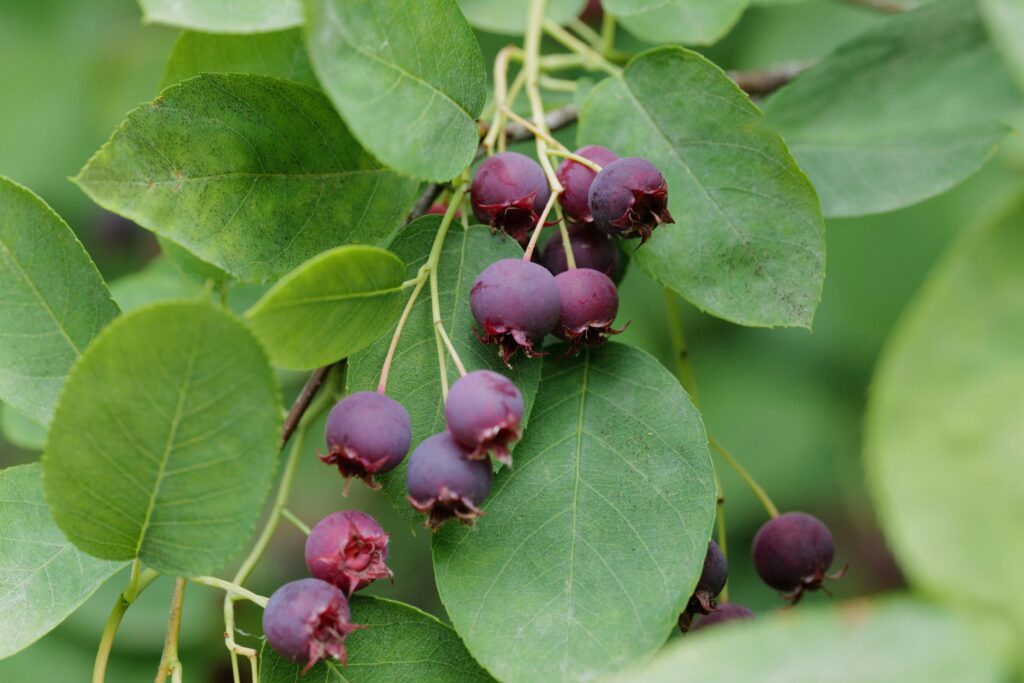
10. Split Pea soup
A delicious Canadian food that sees the humble pea take center stage, in split pea soup they’re cooked with ham hocks, onions, garlic and leeks. Split peas are just normal peas that are dried and split to speed up the cooking process. The result is one of the most filling and hearty Canadian dishes, a soup perfect for cold winter days.
Split pea soup has its origins in ancient civilizations, where legumes served as a basic food source. The technique of splitting peas dates back millennia, making it an effective preservation method for extending the shelf life of these nutritious legumes. It is thought that ancient Egyptians were among the first to grow peas and incorporate them into their culinary traditions.
11. Creton
Creton is a traditional Canadian pork spread originating from Quebec. Made from finely chopped pork, fat, and spices, it has a rich, savory flavor. Typically seasoned with onions, cloves, and sometimes garlic, creton is slow-cooked to develop its creamy texture. It is often served cold as a spread on bread or toast, especially for breakfast or snacks.
12. Maple Taffy
Synonymous with springtime, perfect during crisp, fall days and a sweet treat for winter, this sugary Canadian treat is always in fashion. Made by boiling Maple syrup to a concentrate, Maple taffy was originally an Indigenous tradition. The recipe was then adopted by French settlers in eastern Canada, specifically around Quebec, where groves of maple trees grow the thickest. The taffy is poured in lines on snow or crushed ice and rolled up on sticks for perfect maple lollipops.
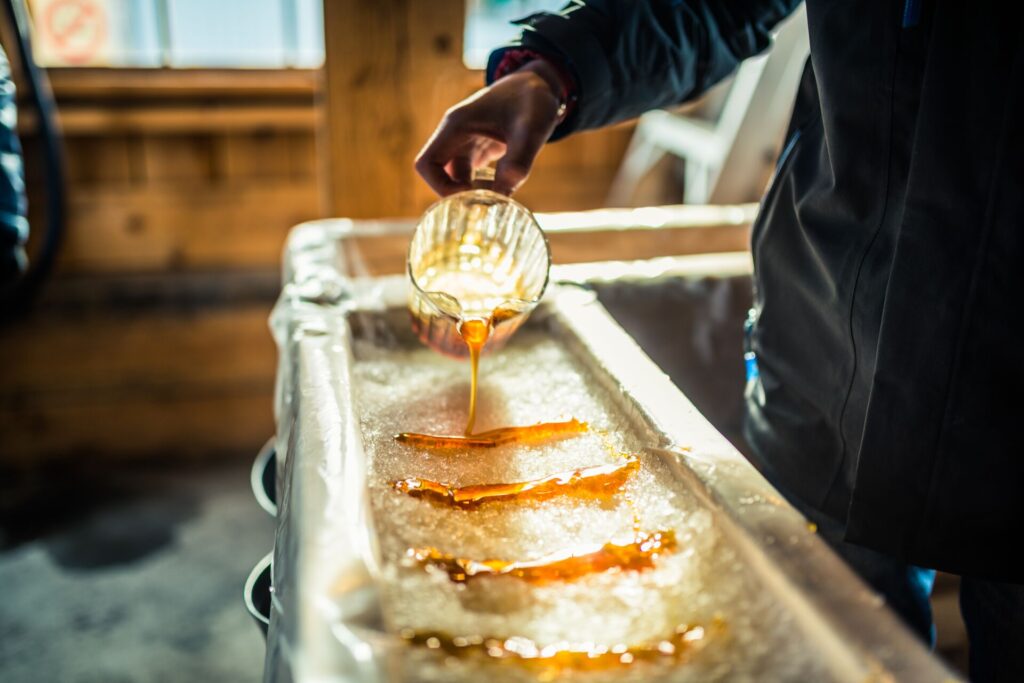
13. Ketchup chips
Adding ketchup-flavored seasoning to potato chips came to be sometime in the 1970s, inspired by the eternal pairing of French fries and tomato ketchup. Now found in nearly all grocery stores, the chips (crisps) are dusted with tomato powder, garlic, onion and spices, infusing smoky, salty and sweet flavors with a tart bite into every crunch.
Although a quintessential Canadian snack, whether the origins of the ketchup chip are Canadian or American remains disputed. But whatever its birthplace, it’s stood the test of time as a Canadian classic.
14. Butter tarts
These buttery, caramel-y tarts are a national obsession for good reason, they’re seriously delicious! A classic Canadian dessert, they’re known for their slightly runny or gooey center which contrasts beautifully with the crisp crust.
The main ingredients include a buttery pastry shell, a filling made of brown sugar or maple syrup, eggs and butter. Some have raisins or nuts for added texture and flavor.
Historically, butter tarts date back to the early 19th century. Their origins are attributed to Canadian pioneers who created simple desserts using locally available ingredients. They’ve since become a beloved Canadian food, often featured at holiday gatherings and special occasions.
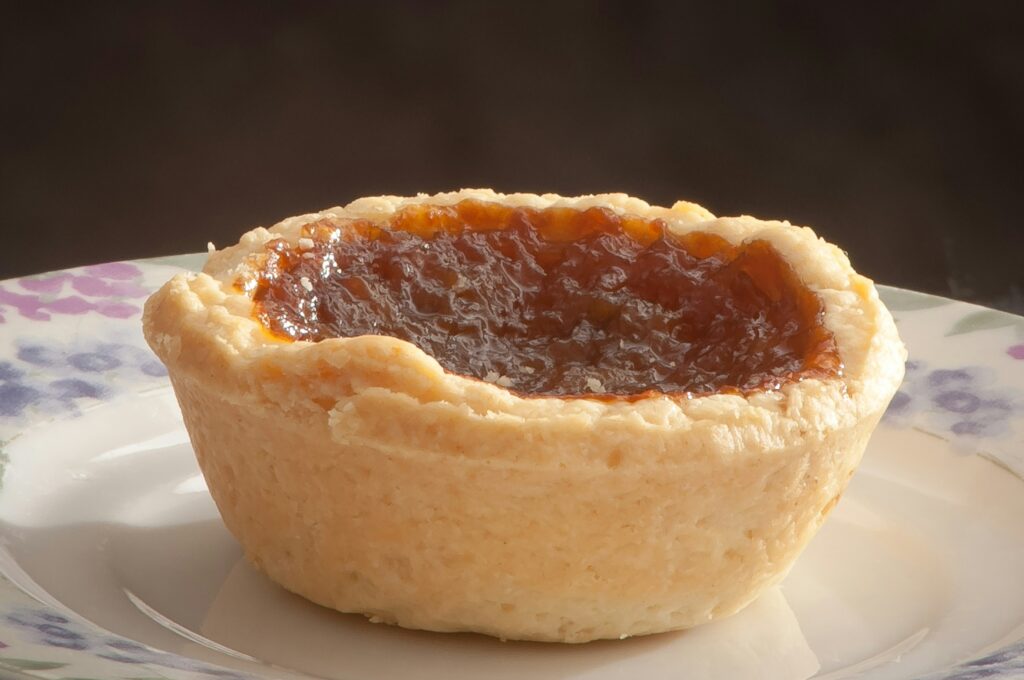
15. Jellied Moose Nose
Jellied Moose Nose is a traditional Canadian delicacy made by boiling a moose’s nose until tender, then cooling it in its own gelatin. Though it may sound a little strange, the dish is described as exploding “with little tastes,” llikened to the flavor of corned beef and for those who enjoy traditional hunting foods, it’s considered a delicacy.
Often served sliced and cold, it showcases the resourcefulness of early Canadians who utilized every part of the animal. Though rare on modern menus, it remains a notable part of Canada’s outdoor and wilderness culinary heritage.
15. Montreal Bagel
The Montreal bagel is one of Canada’s most iconic and beloved snacks. Its precise origins are unclear, but it arrived in Montreal with Jewish immigrants from Eastern Europe in the early 1900s, many of whom settled in the Mile End neighborhood. The Montreal-style bagel is distinctive from its New York counterpart because it is hand-rolled, resulting in uneven shapes and larger holes. Before baking, they are boiled in honey water, which adds a subtle sweetness and contributes to their unique flavor and texture. The result is a bagel that is crispier, slightly sweeter, and more compact than the typical New York-style bagel.

17. Beavertails
Fortunatly not extracted from those cute, furry fellows, BeaverTails are a popular, fried dough pastry that is considered a Canadian treat. They are known for being hand-stretched into the shape of a beaver’s tail and are then fried and topped with various sweet and savory toppings, including cinnamon sugar, maple syrup, and even poutine.
18. Tourtière
Tourtière is a French Canadian meat pie dish originating from the province of Quebec, usually made with minced pork, veal or beef and potatoes. Quebec’s tourtière dates back to the 17th century, likely named after the copper and tin pans used for baking. This hearty meat pie has origins in medieval European noble fare, where elaborately decorated tourtes were popular. Brought to New France during colonization, today’s Montreal and Quebec versions often feature finely ground pork and beef seasoned with cinnamon and thyme. In Saguenay, a deeper, thick-crust version called tourtière du Lac-Saint-Jean is popular, inspired by 18th-century British sea pies with a savory mix of cubed game meats and tender texture.
Save up to $3,000* per couple on your first Premium Tour
Plus receive latest offers, travel inspiration, and discover how your travels will make a positive impact. Together, WE MAKE TRAVEL MATTER®. Subscribe Now19. Maple syrup
Maple syrup is a natural sweetener made from the sap of sugar maple trees. Its origins trace back to Indigenous peoples in North America, who first collected and boiled the sap for nourishment and trade. European settlers later adopted the practice, refining the process. The syrup is produced by tapping maple trees in early spring, boiling the sap to concentrate sugars, resulting in the rich, amber syrup beloved worldwide for its distinctive flavor.

20. Pierogi
Pierogies are filled dumplings originating from Eastern Europe, especially Poland and Ukraine. They have become a popular part of Canadian cuisine, especially in areas with many Eastern European immigrants. Traditionally, pierogies feature a dough filled with potatoes and cheese, then boiled, fried, or sautéed. They are often served as a main dish topped with caramelized onions and sour cream, but can also be enjoyed as a sweet treat with fillings like blueberries or Saskatoon berries and delightful toppings.
21. Date Square
Canadian date squares are a traditional baked dessert consisting of two buttery, brown sugar oatmeal layers with a sweet date paste in between. Variations include adding cinnamon to the oatmeal, flavoring the filling with ingredients like almond extract or lemon zest, and incorporating nuts or candied citrus peel. The biggest variation is its name—across Canada, it’s known by many aliases such as Matrimonial Cake, Date Bars, Toni Cake, and Carré aux dattes, highlighting its popularity and regional differences.
22. Halifax Donair
The donair is a variation of the doner kebab which originated in Halifax, Nova Scotia, Canada in the early 1970s. thin slices of spiced beef laid on a warm Lebanese pita, topped with diced onion and tomato, and finally, drizzled with the sweet garlicky sauce. The Donair is basically Nova Scotian Meatloaf. The story goes, In the 1950s, a man named Peter Gamoulakos, after spending time in Greece, brought the idea of selling traditional gyros to Canada. His first attempt in his pizza shop didn’t succeed, but he adapted the recipe for local tastes by switching from lamb to beef and adding a special sauce. This innovation led to the creation of the Halifax Donair. King of Donair opened its first location on Quinpool Street in 1973, and it has been serving delicious donairs to locals and tourists ever since.
23. Bison Burger
A bison burger typically offers a rich, slightly sweet flavor that is often considered more robust than beef. The meat is leaner, resulting in a juicier yet less fatty texture. Many find bison to be more tender and flavorful, with a subtle earthiness. Canada’s bison industry is expanding due to rising demand for specialty meats, especially among health-conscious consumers, as bison is nutrient-dense but lower in fat, calories, and cholesterol compared to beef or pork.

24. Jigg’s Dinner
Jigg’s Dinner – also known as “boiled” or “Sunday” dinner – is a traditional Canadian meal rooted in Newfoundland and Labrador cuisine. It typically includes boiled salt beef or corned beef, served with side dishes like turnips, carrots, cabbage, and potatoes. Often accompanied by pease pudding, boiled or pickled beetroot, and Yorkshire pudding or bread. This hearty, comforting dish reflects the island’s Jewish and British culinary influences and is enjoyed as a Sunday or special occasion meal, symbolizing community and tradition.
25. Rappie Pie
Rappie pie, described as comfort food on steroids, is a traditional Acadian dish from southwest Nova Scotia, New Brunswick, and parts of Prince Edward Island. Its appearance is quite unusual—a messy, gooey mix of shredded potatoes, meat (such as chicken, game, or clams), and pork fat for flavor. Making it is a labor-intensive and loving process, often taking at least six hours if done properly.
This delicious pie comes not only with a great taste, but also with a storied history. For Nova Scotia’s Acadians, tough times and large families meant that this hearty, communal dish—made from whatever could be spared—became a symbol of resilience and unity. Always stretched to feed many, rappie pie represented perseverance during hardship, bringing people together and reminding them that, despite challenges, their spirit remained strong.
If you are feeling inspired by all this delicious Canadian food, take a look at our premium tours to Canada
LIKED THIS POST? SHARE WITH YOUR COMMUNITY


